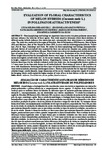Por favor, use este identificador para citar o enlazar este ítem:
http://www.alice.cnptia.embrapa.br/alice/handle/doc/1048472Registro completo de metadatos
| Campo DC | Valor | Lengua/Idioma |
|---|---|---|
| dc.contributor.author | KIILL, L. H. P. | pt_BR |
| dc.contributor.author | FEITOZA, E. de A. | pt_BR |
| dc.contributor.author | SIQUEIRA, K. M. M. de | pt_BR |
| dc.contributor.author | RIBEIRO, M. de F. | pt_BR |
| dc.contributor.author | SILVA, E. M. S. da | pt_BR |
| dc.date.accessioned | 2016-07-08T11:11:11Z | pt_BR |
| dc.date.available | 2016-07-08T11:11:11Z | pt_BR |
| dc.date.created | 2016-07-08 | pt_BR |
| dc.date.issued | 2016 | pt_BR |
| dc.identifier.citation | Revista Brasileira de Fruticultura, Jaboticabal, v. 38, n. 2, p. e-531, 2016 | pt_BR |
| dc.identifier.uri | http://www.alice.cnptia.embrapa.br/alice/handle/doc/1048472 | pt_BR |
| dc.description | Floral morphology and biology are important characteristics for plant-pollinator interactions and may influence the behavior of these agents. This study aimed to determine which floral attributes of different melon hybrids influence this interaction and, consequently, their attractiveness in simultaneous crops. The study was conducted in the region of Petrolina, State of Pernambuco (PE)/Juazeiro, State of Bahia (BA) and Mossoró, State of Rio Grande do Norte (RN), in areas with the following melon hybrids: Yellow type, Piel de Sapo, Cantaloupe and Galia. For studies on floral morphology and biology, hermaphrodites and male flowers of each hybrid were analyzed for their size and nectar chamber size, pollen and nectar production, anthesis time and flower lifespan. Floral visitors were observed simultaneously in hybrids of three types of melon, from 5:00 a.m. to 6:00 p.m., in the two study sites. Evaluations of the corolla diameter and flower height indicated that the hermaphrodite flowers were larger in size than male flowers in all types of melon investigated, in both study sites. As for nectar chamber, male flowers are larger in width, but smaller in height, compared to hermaphrodite flowers. Regarding the volume of nectar, differences were found between floral types for the hybrids evaluated, in the two study sites; the hermaphrodite flowers produced 2-7 times more nectar than male flowers in all studied hybrids. Observations of visits of Apis mellifera to areas with simultaneous flowering of the three types of melon demonstrated differences in the frequency of visits between hybrids, floral type and foraged resource. Flowers of the hybrids Piel de Sapo and Cantaloupe exhibited larger corolla diameter, larger dimensions of the nectar chamber and greater supply of resources for foraging, which could explain the higher number of visits of bees to their flowers in the sites studied. | pt_BR |
| dc.language.iso | eng | eng |
| dc.rights | openAccess | eng |
| dc.subject | Biologia floral | pt_BR |
| dc.subject | Recurso floral | pt_BR |
| dc.subject | Anthesis | pt_BR |
| dc.subject | Floral resources | pt_BR |
| dc.title | Evaluation of floral characteristics of melon hybrids (Cucumis melo l.) in pollinator attractiveness. | pt_BR |
| dc.type | Artigo de periódico | pt_BR |
| dc.date.updated | 2017-01-30T11:11:11Z | pt_BR |
| dc.subject.thesagro | Melão | pt_BR |
| dc.subject.thesagro | Polinização | pt_BR |
| dc.subject.thesagro | Néctar | pt_BR |
| dc.subject.thesagro | Cucurbitaceae | pt_BR |
| dc.subject.thesagro | Pólen | pt_BR |
| riaa.ainfo.id | 1048472 | pt_BR |
| riaa.ainfo.lastupdate | 2017-01-30 | pt_BR |
| dc.identifier.doi | 10.1590/0100-29452016531 | pt_BR |
| dc.contributor.institution | LUCIA HELENA PIEDADE KIILL, CPATSA; EDSÂNGELA DE ARAÚJO FEITOZA, Bolsista/Funbio; KÁTIA MARIA MEDEIROS DE SIQUEIRA, Profa. Titular da Universidade do Estado da Bahia-DTCS, Juazeiro-BA; MARCIA DE FATIMA RIBEIRO, CPATSA; EVA MÔNICA SARMENTO DA SILVA, Profa. da Universidade Federal do Vale do São Francisco. | pt_BR |
| Aparece en las colecciones: | Artigo em periódico indexado (CPATSA)  | |
Ficheros en este ítem:
| Fichero | Descripción | Tamaño | Formato | |
|---|---|---|---|---|
| Kiill2016.pdf | 1.93 MB | Adobe PDF |  Visualizar/Abrir |









